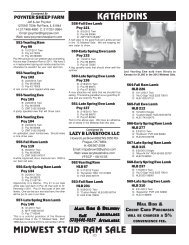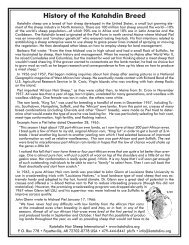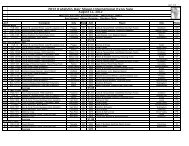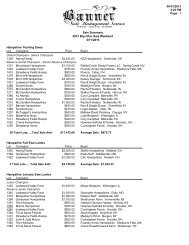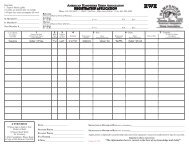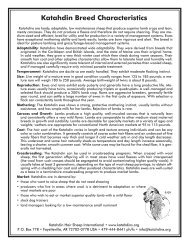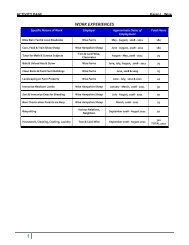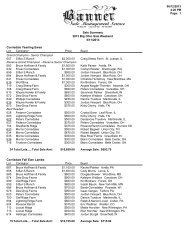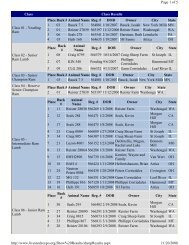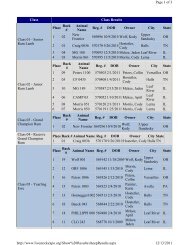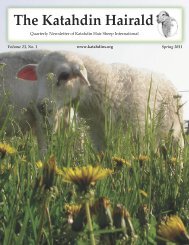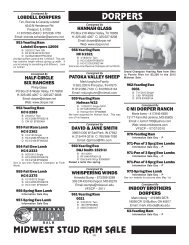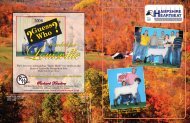KHSI Hairald Summer 2007
KHSI Hairald Summer 2007
KHSI Hairald Summer 2007
Create successful ePaper yourself
Turn your PDF publications into a flip-book with our unique Google optimized e-Paper software.
BIRTH TYPE, CONTINUED FROM PAGE 6<br />
b) Even at a high percentage of<br />
single births (see 2 yr old ewes<br />
in Figure 1 and Table 1), there<br />
are still a few triplet litters. It is<br />
almost impossible to rid the flock<br />
of triplet lambing ewes without<br />
taking the flock lambing average<br />
to one lamb/ewe. That is a very<br />
expensive approach to ridding<br />
the flock of triplets.<br />
c) As the ewe increases in age,<br />
the percentage of twinning litters<br />
maximizes at 60-65% (Figure<br />
1 and Table 1). There is very<br />
little difference in the percentage<br />
of twins in the 3, 4 and 5-6 age<br />
classes of ewes (Figure 1). Numbers<br />
of single and triplet births<br />
vary more with the numbers of<br />
triplet litters increasing as prolificacy<br />
increases.<br />
d) If a shepherd wishes to minimize<br />
the number of single litters,<br />
they will need to greatly increase<br />
the number of triplet litters.<br />
Why can’t we obtain a ewe flock<br />
only twins? If a shepherd selects<br />
rigorously for twinning genetics<br />
by culling mature ewes who single<br />
or triple, shouldn’t his/her flock<br />
eventually have greater than 60-<br />
65% twins? The answer<br />
to this question arises<br />
from the fact that prolificacy<br />
on average is<br />
10% genetic (heritable)<br />
and 90% environment<br />
(management, nutrition,<br />
climate, stress and some<br />
random effects). Therefore,<br />
even with strong<br />
selection for twinning, a<br />
little variation in nutrition<br />
or some change in stress<br />
(for better or worse) during<br />
ovulation can push<br />
an individual ewe or the<br />
flock toward either more<br />
triplets or singles.<br />
There are several environmental<br />
and management<br />
practices that<br />
will shift a flock’s lambing<br />
percentage. These act on the<br />
genetics for prolificacy. Some of<br />
these factors are included in Table<br />
2. For example, ewes typically are<br />
less prolific when bred in the spring<br />
rather than in the fall. Therefore, if<br />
the goal of a fall lambing flock is to<br />
average twins, besides selecting for<br />
aseasonal ewes, a shepherd will also<br />
typically need ewes that are genetically<br />
more prolific. Better nutrition<br />
increases prolificacy and decreasing<br />
nutritional plane typically decreases<br />
prolificacy. A shepherd can select for<br />
ewes that lamb at the preferred percentage,<br />
but if management or environment<br />
is changed, their prolificacy<br />
is likely to change.<br />
In summary, we can conclude<br />
that if the shepherd wishes to have<br />
few triplet litters (< 1%) in his/her<br />
2+ year old ewes, they will need to<br />
select for a flock that has at least<br />
70% singles. That may not be the<br />
best financial choice. If a shepherd<br />
wishes to have few single births<br />
(



